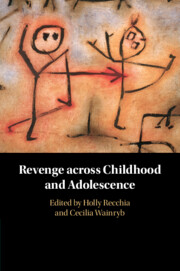Book contents
- Revenge across Childhood and Adolescence
- Revenge across Childhood and Adolescence
- Copyright page
- Dedication
- Contents
- Figures
- Tables
- Contributors
- Acknowledgments
- Chapter 1 And If You Wrong Us, Shall We Not Revenge?
- Chapter 2 A Framework for Understanding Variation in Youth Revenge Motivations and Retaliatory Behaviors
- Chapter 3 Normative Changes and Individual Differences in Retaliation Judgments
- Chapter 4 Developing Revenge in Early Childhood
- Chapter 5 Understanding Youths’ Retaliatory Experiences through the Lens of Moral Agency
- Chapter 6 Cultural Systems and the Development of Norms Governing Revenge and Retribution
- Chapter 7 Settling the Score in a Zero-Sum Game
- Chapter 8 Intergroup Processes
- Chapter 9 Revenge, Justice Systems, and Institutional Trust in Schools
- Chapter 10 The Importance of a Positive School Climate in Addressing Youth Retaliation
- Chapter 11 Socioemotional Competencies and Positive Classroom Climate as Alternatives to Prevent Revenge in Colombian Schools
- Chapter 12 Looking Back and Charting a Course
- Index
- References
Chapter 6 - Cultural Systems and the Development of Norms Governing Revenge and Retribution
Published online by Cambridge University Press: 08 July 2021
- Revenge across Childhood and Adolescence
- Revenge across Childhood and Adolescence
- Copyright page
- Dedication
- Contents
- Figures
- Tables
- Contributors
- Acknowledgments
- Chapter 1 And If You Wrong Us, Shall We Not Revenge?
- Chapter 2 A Framework for Understanding Variation in Youth Revenge Motivations and Retaliatory Behaviors
- Chapter 3 Normative Changes and Individual Differences in Retaliation Judgments
- Chapter 4 Developing Revenge in Early Childhood
- Chapter 5 Understanding Youths’ Retaliatory Experiences through the Lens of Moral Agency
- Chapter 6 Cultural Systems and the Development of Norms Governing Revenge and Retribution
- Chapter 7 Settling the Score in a Zero-Sum Game
- Chapter 8 Intergroup Processes
- Chapter 9 Revenge, Justice Systems, and Institutional Trust in Schools
- Chapter 10 The Importance of a Positive School Climate in Addressing Youth Retaliation
- Chapter 11 Socioemotional Competencies and Positive Classroom Climate as Alternatives to Prevent Revenge in Colombian Schools
- Chapter 12 Looking Back and Charting a Course
- Index
- References
Summary
Normative systems known as honor, face and dignity system may have evolved as cultural adaptations to the survival challenges posed by quite different ecologies. Theory that views culture as situated cognition (Oyserman, 2017) posits that regionally dominant systems provide environmental cues that preferentially elicit normative thoughts, emotions and behaviors. Systems of shared norms help people coordinate actions and manage conflicts within their group. In the United States, successive waves of European colonization established cultural legacies that survive as regional differences, currently reflected in crime statistics and behavioral research. This chapter examines potential mechanisms of high rates of vengeful aggression within honor systems. Individual influences may include emotion socialization, hostile attribution biases, beliefs that behavior is stable, criteria for self-worth, and masculine anxiety. Theory and research indicate that institutional failure to protect and provide justice to all group members creates conditions linked to the contemporary evolution of honor norms in social groups.
Keywords
- Type
- Chapter
- Information
- Revenge across Childhood and Adolescence , pp. 127 - 160Publisher: Cambridge University PressPrint publication year: 2021
References
- 1
- Cited by

